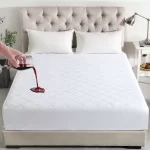What Are Some Benefits Of Anti-Allergy Bedding?
A restful night’s sleep is essential for overall well-being, but for many people, allergies can turn bedtime into a nightmare. From sneezing and itching to congestion and wheezing, allergies can disrupt sleep and leave individuals feeling tired and irritable during the day. Fortunately, anti-allergy bedding has emerged as a solution to this problem, providing a range of benefits that go beyond simply improving sleep quality. In this article, we’ll delve into the various advantages of anti-allergy bedding.
- Allergen Protection
One of the primary benefits of anti-allergy bedding is its ability to block allergens effectively. These allergens include dust mites, pet dander, pollen, and even mold spores. Anti-allergy bedding is typically made from tightly woven materials that create a barrier, preventing allergens from penetrating the bedding and coming into contact with the sleeper. This protection can significantly reduce allergic reactions and symptoms.
- Improved Sleep Quality
When allergies are kept at bay, sleep quality naturally improves. Anti-allergy bedding ensures that individuals can sleep through the night without being disturbed by sneezing fits, itchy skin, or congestion. Better sleep quality leads to increased daytime alertness, improved mood, and enhanced overall health.
- Asthma Management
People with asthma often find that their symptoms worsen at night due to exposure to allergens. Anti-allergy bedding can play a crucial role in asthma management by reducing exposure to allergens that trigger asthma attacks. This can lead to fewer nighttime asthma symptoms, fewer emergency room visits, and an improved quality of life for asthma sufferers.
Anti-allergy bedding is typically made from hypoallergenic materials. These materials are less likely to trigger allergic reactions, making them an excellent choice for individuals with sensitive skin or respiratory conditions. Common hypoallergenic materials used in bedding include microfiber, silk, and certain types of cotton.
- Durability
High-quality anti-allergy bedding is built to last. It is designed to withstand frequent washing and maintain its effectiveness in allergen protection. While anti-allergy bedding may initially be a slightly more significant investment, its durability ensures that it continues to provide benefits for an extended period, ultimately saving money in the long run.
- Easy Maintenance
Anti-allergy bedding is easy to care for. Most products are machine washable and can be regularly cleaned to remove allergens that may have accumulated over time. This low-maintenance aspect makes anti-allergy bedding a practical choice for anyone looking to manage allergies effectively.
- Peace of Mind
Knowing that your bedding is working to protect you from allergens can provide peace of mind. It allows individuals to relax and enjoy their sleep without worrying about potential allergic reactions. This psychological benefit can have a positive impact on overall well-being.
Conclusion
Anti-allergy bedding offers a multitude of benefits beyond its primary function of reducing allergic reactions. It enhances sleep quality, manages asthma symptoms, and provides peace of mind. Furthermore, it is crafted from hypoallergenic materials, ensuring durability and easy maintenance. If you or a loved one suffers from allergies or asthma, investing in anti-allergy bedding may be a practical and beneficial choice to enjoy a restful night’s sleep and improved overall health.
If you would like any further information please Contact one of our friendly team at Cover and Protect Mon-Fri on 02 931 66654 (Sydney, NSW) or mob: 0408 113 089 (7 Days) or drop us an email at sales@coverandprotect.com.au will get back to you ASAP.




